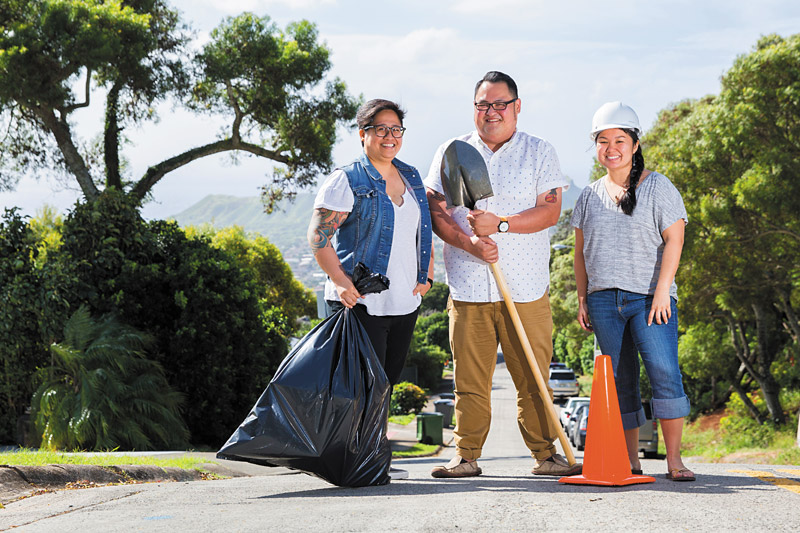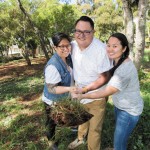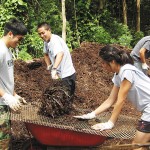Hands In Helping Out

In 2009, three friends (pictured, from left: Shar and Ryan Leong, and Cheri Kishimoto) started their own nonprofi t to connect volunteers with organizations that need them. Now, their Hands In Helping Out is expanding its reach.
While they were attending University of Hawaii at Manoa, husband and wife Ryan and Shar Leong and their friend Cheri Kishimoto discovered that they loved volunteering. The feeling, however, wasn’t always so mutual.
Sure, nonprofit organizations and community groups always needed people to help out, but at times, it was hard for Kishimoto and the Leongs to find the right opportunity. Other times, groups they worked with didn’t always have the capacity to manage volunteers. At some events, tasks were not explained well, or volunteers would not even be assigned a job at all.
“That is what we found was the going standard — there was no real structure involved in terms of volunteering with lots of different organizations,” Shar recalls.
So to remedy the situation for their friends — they had a group of about 15 that they’d regularly volunteer with — Kishimoto, Ryan and Shar began taking the reins, researching new opportunities and guiding their friends during events.
What started as a gathering of college friends now has blossomed into a full-fledged nonprofit, Hands In Helping Out (HIHO), which they founded in 2009 as a means to improve the volunteer experience in order to increase volunteerism as a whole. That goal always has been an admittedly ambitious one, and now HIHO’s aspirations are getting even loftier. In the coming year, with new programs and an expanded approach, HIHO is poised to extend its reach.
- HIHO co-founders (from left) Shar and Ryan Leong, and Cheri Kishimoto
- HIHO volunteer Robert Belgrod working with Kupu at Kako’o O’iwi
- A group of HIHO volunteers, (from left) Marcus Hoapili, Matt Kugiya, Tiffany Kugiya and Erin Farmer, at Kokua Kalihi Valley’s Ho’oulu ‘Aina program HIHO PHOTOS
‘THINGS ARE GOING TO GET DONE’
About three years ago, Aloha Harvest, which distributes food to other social service groups, was preparing for a big silent auction. But the staff had never run an auction before, so they turned to HIHO.
“(HIHO) organized the whole thing,” recalls Aloha Harvest executive director Ku‘ulei Williams, “and it ended up being a really smooth-running (event).
“They are really good with planning and organizing and getting people that we can really count on. I never have to worry about anything when they are involved with my staff,” Williams adds. “I can just rely on them that things are going to get done.”
By working with nonprofits, community groups and social service businesses, HIHO helps them expand their goals, allowing them to have greater impacts. Today, HIHO has 17 partner organizations including Hawaii Literacy, Special Olympics Hawaii, Kokua Hawaii Foundation, HUGS and Hawaii Nature Center.
With a volunteer-first approach, they reason, individuals are more likely to return. HIHO has worked with thousands of volunteers who have contributed more than 10,000 hours of service.
Part of their goal in increasing volunteerism has been to target a traditionally tricky group to reach: young adults.
In HIHO’s early days, the Leongs and Kishimoto were in their mid-to-late 20s, and they were not always well-received: “When we got out to organizations, sometimes people looked at us and they didn’t know what to do with us,” Ryan says.
“We were looked at under a discriminatory lens, almost,” Shar adds.
Statistically, there was some validity to that. The Bureau of Labor Statistics reports that (according to 2014 data) while adults ages 35-44 are the age group most likely to volunteer, rates among younger adults are the lowest.
Yet, HIHO’s average age is about 30.
Kishimoto, Ryan and Shar postulate that the reason behind these lower rates of volunteerism may have something to do with the way that some opportunities are structured; some groups they’ve come across require volunteers commit to a certain amount of time before they participate in certain activities. And young adulthood is an era when most people are just launching their careers or starting families — things that take up a lot of time.
“(Volunteers) are going to have times when they are going to have to fall off for a little while,” Ryan says. “Our program allows them to do what they can when they can.”
And getting them young is important.
“At this time in your life, you are figuring out where things fit into your day-today,” Kishimoto says. “If we can fit volunteering into that time, then it becomes something that has potential to be fit into your life throughout the rest of your years.”
BECOMING ‘EXPONENTIALLY GREATER’
On any given day, HIHO volunteers can be found at various work sites throughout the island — there was one marathon weekend, for example, when they managed to facilitate seven different events. But the reality exists that the three co-founders can only be so many places at once, which is compounded by the fact that each has a full-time job — Ryan as an associate executive director at Kalihi YMCA, Shar as a graphic designer and Kishimoto as a high school math teacher.
Earlier this year, HIHO launched HIHO Academy, which trains its volunteers to guide others, allowing them to be present at more events simultaneously.
They’re also working on a forthcoming program called HIHO Education Department, which will offer classes for its partner organizations with the goal of helping agencies improve their own volunteer experiences.
“Early on we said we can change volunteers but we can’t change agencies,” Ryan explains. “But then we thought, why can’t we?”
After all, many organizations already turn to HIHO to help them manage their other volunteers. (It is, for example, something that Aloha Harvest says HIHO has done for them on an informal level: “Working with HIHO and seeing how they operated, it kind of gave my staff a better understanding of what we needed to put in place to be able to manage volunteers on our own,” Williams says.) The course will guide organizations in managing volunteers, recruitment, event facilitation and follow-up.
“We can’t be in every organization.” Kishimoto says. “But if the organization can provide something similar, then our impact is going to be exponentially greater.”
TINY VICTORIES
Kishimoto speaks in fluid, complete paragraphs. You’d never know it, but she swears that is something that, before HIHO, she could never do.
“I am a pretty reserved person,” she says. “I used to get very anxious about talking to new people.”
Through having to interact with volunteers and foster HIHO partnerships, Kishimoto got better and better at public speaking. Her leadership skills have developed to the point where, in the new year, she will be taking over as the next HIHO executive director.
This type of thing has been an unanticipated fringe benefit that has arisen among HIHO participants, the co-founders say. While much of HIHO’s focus is on the agencies, there are the smaller-scale impacts that manifest in the volunteers themselves.
“We are different people now,” Ryan says. “We don’t talk about that too much with the volunteers, because that is kind of a weird thing to say — ‘We are going to change you.'”
“But it is sort of an intangible thing that happens,” Shar adds.
That notion rings true for Ryan and Shar as well: Shar has honed her skills as a graphic designer, creating the HIHO logo and other materials; Ryan credits the leadership experience he’s gained through HIHO for helping him advance at his day job.
“We have told our volunteers from the beginning, you should be able to get something out of it — whether it is experience or social skills, or taking this opportunity to network,” Shar says.
For all that HIHO has done, much of the way Kishimoto, Ryan and Shar talk about it is in incremental terms — the effects on each individual organization; the way it’s transformed individual volunteers.
The impact of the group is then, perhaps, found in the small moments, the tiny victories. Like how one of the first organizations they started working with was Kokua Kalihi Valley, which at the time, had recently begun running community work days in their garden. It was a small group initially, and HIHO brought food for its volunteers, while sharing with anyone else on site. Now, the work days have grown, and Kokua Kalihi Valley has gotten in the habit of providing the food. At the end of the day, everyone gathers around the table.
“They tell us, ‘This really started with you guys,'” Ryan says. “We saw the community grow around that table. And now there is so much food, so many people, and there is always enough for everybody.”
TO LEARN MORE ABOUT HIHO, VISIT HIHO.ORG.




